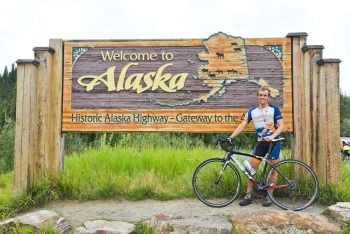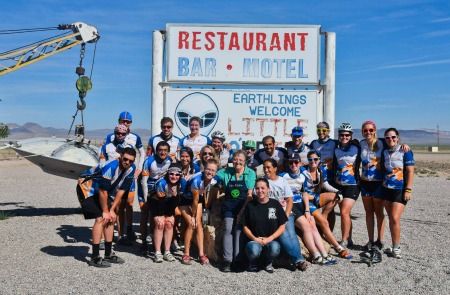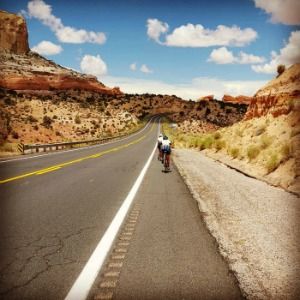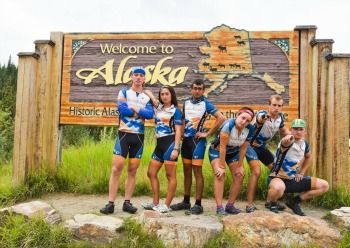
The Texas 4000, a 4,000 plus mile bike ride from Austin, Texas to Anchorage, Alaska, competitively selects University of Texas students to participate in their 18-month program designed to cultivate leaders in the fight against cancer. Brother Nick Sehy (Delta Mu/Texas 2017) decided he was up for the challenge.
“I saw Texas 4000 at campus orientation freshman year,” said Sehy. “When I got onto campus I was looking for a challenge, and after much thought, I decided that I should apply to the Texas 4000 organization. I could challenge myself and do something to support my family. I just lost a cousin to brain cancer, my mom was diagnosed with bladder cancer when she was a med student raising me and my twin sister, my grandma has a form of leukemia, and my uncle has non-Hodgkins lymphoma. Obviously cancer is overwhelming in my family, so I thought it made sense for me to apply,” he continued.
After a round of cuts and interviews, Sehy was one of about 100 people to make the team. Next came 18 months of training, 1,500 miles of riding, fundraising, setting up ride leaders, organizing their stops on their route. Finally, on May 29, 2015, the riders were ready to depart.
There are three different routes for the Texas 4000. The Ozarks route begins by going south toward the MD Anderson Cancer Center in Houston and then goes east toward New Orleans, and then straight north toward Chicago. In Chicago the route cuts northwest across Minnesota and picks up the Alaskan Highway in Canada heading toward Alaska. The Rockies route goes north from Austin toward Dallas, and then heads to Colorado, goes through Yellowstone, Glacier National Park, Banff, and slowly makes its way through Canada to Alaska. The third route, the Sierra route, is the route that Sehy’s team of 22 riders took. They began heading west toward New Mexico, zigzagged through the four corners states, cut through southern Nevada, and made their way west toward San Francisco and up the coast through Portland, Seattle, and Vancouver before heading toward Anchorage. After sixty days of riding, all three routes meet up again in Whitehorse, in the Yukon, and ride into Anchorage for the last ten days.

“We averaged about 70 miles a day for 70 days. Our longest day was about 120 miles. That same day we crossed from Canada into Alaska,” said Sehy.
Along the way the riders make numerous planned stops and are often met by supporters, media, etc. Was there a stop that was special for you?
“There was a special stop in southern Nevada. We biked about a hundred miles June 18th in the middle of the desert. We had to take rest stops about every 10 miles to refill water. On top of the heat, there were a couple of long climbs that made the ride drag on harder and longer than expected. By the time we finally stopped around 5 p.m., we reached Rachel, Nevada, a 54-person town just north of Area 51. When I arrived, I spotted a water spout in the middle of the town and wasn’t embarrassed to put my face under the spout and drink for a couple of minutes,” said Sehy.
“We stayed at the ‘Little A’le Inn,’ a pun three or four times over. The ‘inn’ was a collection of trailer homes surrounding the main bar,” Sehy laughed. “Most of the people residing in Rachel were alien-seekers, some type of drug addict, or ran the Little A’le Inn. In most cases, two or three of the categories applied to an individual,” he said.
“During our programs, we commonly would tell people that one of the goals of Texas 4000 was to ‘create a humble metaphor for cancer,’” said Sehy. “That day was one of the days that I truly felt like this was true. After getting settled, I drifted to the bar, where an old lady who we would later find out was Ms. Patt told me that my mom had called. She asked Ms. Patt if she could make me a red velvet cake for my birthday. Somehow my mom had gotten a hold of this inn in the middle of the desert, and Ms. Patt had gone a couple hours out of her way to buy red velvet cake mix for me,” Sehy exclaimed. “After our team celebrated my birthday, Ms. Patt surprised the team with a mail drop. About 20 days into the ride, this was one of the best things that we could have asked for,” he explained. “Since the team’s goal was not to spend fundraising dollars on food, we generally had to get resupplied with mail drops or by asking for donations, which were hard to come by in the middle of the desert. In my mail drop I was sent new sunglasses, sun sleeves, and tons of snacks to fill me up until the next mail drop. Rachel seemed like an oasis that day and I still cannot believe my mom found a way to get me a cake,” Sehy concluded.

Over the next two days the team continued their trek across the desert toward California.
What did you like most about this experience?
“The great thing about Texas 4000 was how simple it was. Get up at 5 or 6 a.m., bike your mileage to the next town, interact with your hosts, and then sleep. You didn’t have to worry about what the plan was for the next day, we had all set it up before the ride. Small things like getting a Sonic donation or getting a bed to sleep in instead of your sleeping bag amounted to being grateful for the smallest things. When I was stripped of all the materials that I took for granted in daily life, I was a happier person,” said Sehy.
What was your favorite part of the journey?
“I can’t pick out one! The Pacific Northwest is amazing. Riding through the Avenue of the Giants in northern California was incredible. Also riding along the Oregon coast along highway 101, into Portland, Seattle and then along the Puget Sound was breathtaking. Mt. Rainier was a sight to see. Vancouver, the Sea-to-Sky highway and Whistler contain some of the prettiest places I’ve ever been to in North America,” said Sehy. “Also when you get to Alaska, and Northern Canada you truly are part of the wilderness. It was a daily occurrence for ride groups to see bears and moose. There are little towns along the way that truly are just outposts for gas and food. However, the scenery is top notch and everywhere you are surrounded by forest and snow-capped mountains that are the highest on the continent,” he continued.
Was there anything about the trip in particular that surprised you?
“What surprised me the most on the trip was the generosity of people,” said Sehy. “Almost every day we had a family or group of families volunteer to take a group of 22 bikers into their homes and feed us what they could offer. I stayed with an older couple in Olympia that knitted our team a blanket. When we arrived in Vancouver our team met up with a bike group called Ride 2 Survive that cleaned our support vehicles and gave us a thousand dollars worth of new tubes, tires and food. Every day we had to interact with managers of fast food chains, restaurants and grocery stores, and many of them would find a way to give to us. It was truly amazing to see how much people would sacrifice for us to get to Alaska,” he added.

What will you take away from this experience?
“If I would take away anything from the ride, it would be the fact that even though I saw some of the most beautiful sights in America, the ride wouldn’t have been memorable without the relationships I created. By the end of a 70 day ride together, I knew twenty-one other people that I could trust and were looking out for my best interests. It was something that we all strive for when we decided to take the bid to join Theta Chi, and I was blessed that I found it again when I decided to bike to Alaska,” said Sehy.
So how much did your team raise during this ride?
“Each rider has to personally raise $4,500 to be able to go on the journey. We ended up raising more than $720,000 and I was personally able to raise more than $10,000,” said Sehy. “Since the organization’s founding in 2004, it has raised more than 5.5 million dollars that goes to MD Anderson’s Cancer Center, UT’s biomedical engineering research, and many smaller cancer fighting organizations across the continent,” he continued.
Would you recommend participating in the Texas 4000 to your brothers of Theta Chi?
“I would definitely recommend doing something like this,” said Sehy. “Texas 4000 is only for University of Texas students, but I know there are rides all over the country that cross a state and a couple that criss-cross the contiguous U.S. It would be neat if Theta Chi would create an opportunity for us to participate in a journey such as Texas 4000 so we can form a stronger national brotherhood, raise money for Wounded Warriors Project, and promote our fraternity,” Sehy concluded.
For more information on the Texas 4000, visit http://www.texas4000.org/





